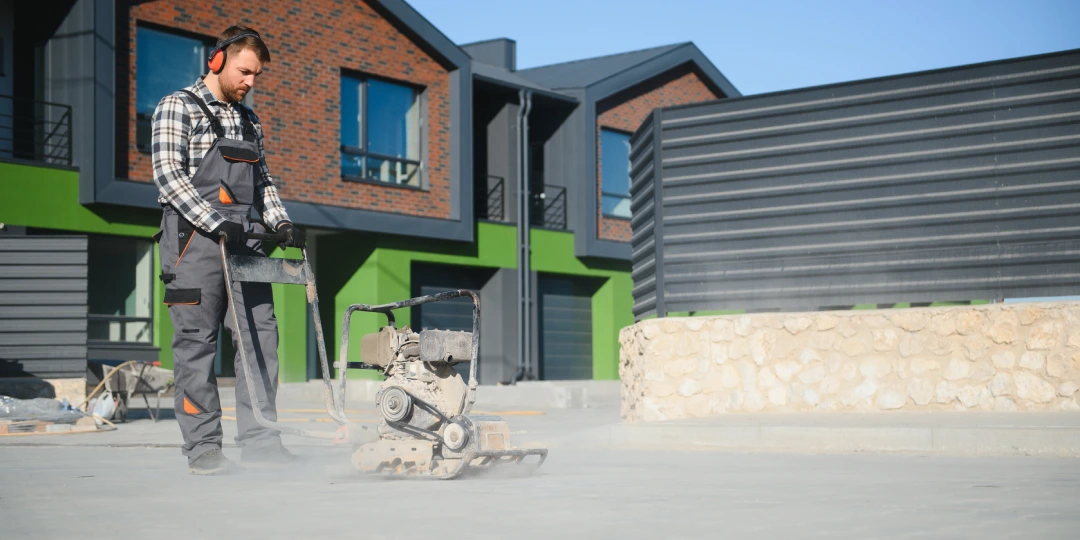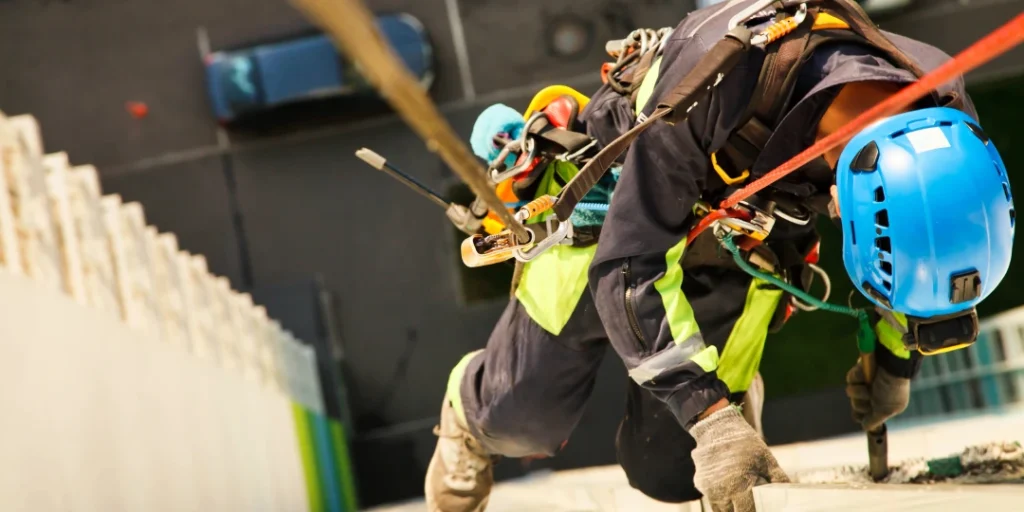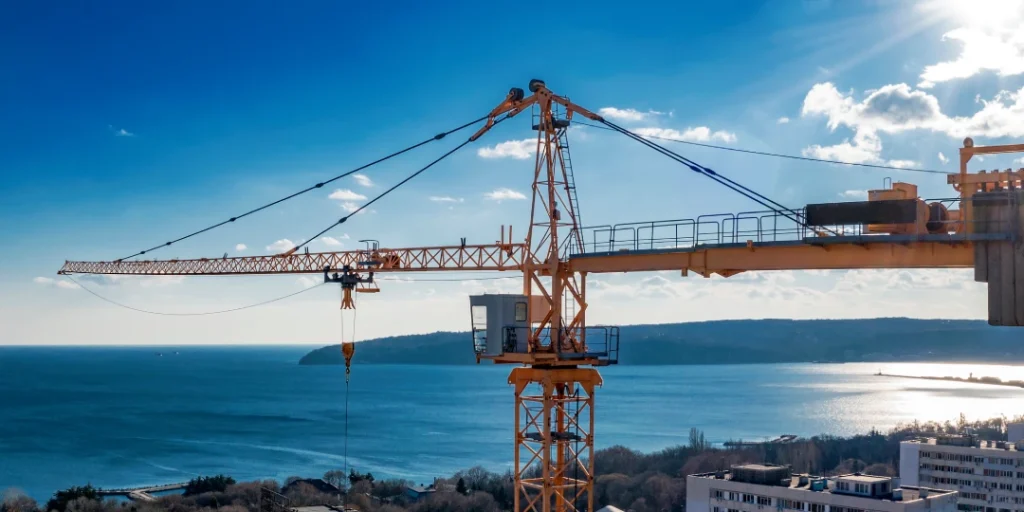What Is Silica Dust and Why It Matters in Construction
Silica dust is an airborne threat that hides in plain sight. It’s released into the environment during common construction activities like cutting, crushing, or drilling materials such as concrete, stone, brick, or mortar. These tasks break down crystalline silica into fine particles—many of which are small enough to travel deep into the lungs. Unlike sawdust or visible debris, silica dust can’t be seen with the naked eye, which makes it uniquely hazardous on busy job sites where attention is split and PPE use varies.
When inhaled, respirable crystalline silica embeds itself in lung tissue. Over time, this can lead to silicosis, an incurable and often fatal lung disease. Even short-term exposure, repeated daily without proper control measures, increases the risk of long-term health effects like lung cancer and kidney disease. Fortier Loss Control works closely with construction teams to help identify where silica dust is likely to be generated, often revealing overlooked hazards in routine tasks.
Understanding silica dust is only the beginning. At Fortier Loss Control, the emphasis is on turning awareness into actionable prevention. Their consultants not only educate crews about the dangers but also implement control plans tailored to each project’s specific risks. This isn’t just about meeting regulations—it’s about protecting lives. Fortier helps contractors take invisible risks seriously and manage them before health issues or citations force the conversation.
Nashville’s Construction Boom: A Perfect Storm for Exposure
Nashville’s skyline has become a showcase of rapid development. New residential towers, office buildings, mixed-use spaces, and public infrastructure projects are popping up across the city and suburbs. While this boom is a sign of economic vitality, it also creates the ideal conditions for widespread silica dust exposure. With so many crews working simultaneously—often on compressed timelines—safety planning can be outpaced by production pressures.
The increased volume of demolition and concrete work means more workers are exposed to airborne silica dust every day. Small contractors, who may lack a dedicated safety department, often rely on legacy habits rather than updated compliance practices. Fortier Loss Control steps in as a strategic partner to assess job sites, identify exposure risks, and implement tailored controls before the dust becomes a liability. They help employers build safer workflows from the ground up.
The challenge is especially acute on busy urban job sites where multiple trades are active in confined spaces. Silica dust doesn’t respect boundaries—it can drift from one crew’s work into another’s breathing zone. Fortier emphasizes coordinated safety plans that address all trades on site, ensuring consistent use of dust controls and personal protective equipment. Their involvement ensures Nashville’s construction progress doesn’t come at the cost of worker health or regulatory fallout.
Health Risks Associated with Crystalline Silica
The dangers of silica dust don’t end at the worksite—they follow workers home and grow over time. Once inhaled, the microscopic particles can cause silicosis, a scarring of the lung tissue that gradually restricts breathing and oxygen absorption. This disease can take years to manifest, and by the time symptoms appear—chronic cough, shortness of breath, and chest pain—the damage is often irreversible. Without medical surveillance or exposure controls, the hazard remains hidden until it’s too late.
Beyond silicosis, silica dust has been classified as a Group 1 carcinogen by the World Health Organization. Long-term exposure increases the risk of developing lung cancer, especially in workers who also smoke or have a history of respiratory illness. Kidney damage and autoimmune disorders like lupus and rheumatoid arthritis have also been linked to crystalline silica, making it one of the most broadly harmful airborne contaminants in construction. The medical costs, lost time, and human toll are staggering.
Fortier Loss Control takes a prevention-first approach to combat these risks. Their team helps companies implement exposure tracking, enforce medical evaluations where required, and integrate safety culture into everyday operations. Rather than simply reacting to incidents, Fortier focuses on building awareness from top leadership down to crew level. Their goal is to shift safety from being a compliance checkbox to a genuine commitment—because the consequences of ignoring silica dust don’t stay on the job site.

OSHA’s Respirable Crystalline Silica Rule: What You Need to Know
OSHA’s Respirable Crystalline Silica Standard for Construction, codified in 29 CFR 1926.1153, sets clear expectations for employers—but compliance isn’t always straightforward. The rule limits worker exposure to 50 micrograms per cubic meter of air over an 8-hour shift and requires companies to implement a written exposure control plan, use engineering controls where feasible, and provide medical exams for workers exposed above the action level. It’s not just policy—it’s enforceable law.
Many construction companies, especially smaller firms or subcontractors, struggle with how to meet these obligations. Do they need to monitor air quality? When does a respirator program become mandatory? Are their current controls adequate? Fortier Loss Control provides detailed, site-specific guidance that helps employers answer these questions confidently. Their consultants conduct task-based risk assessments and walk clients through each regulatory requirement, ensuring nothing is missed.
OSHA enforcement in Tennessee has been active, and fines for noncompliance with silica standards can reach tens of thousands of dollars per violation. But Fortier helps clients go beyond avoiding citations—they help build sustainable safety systems. By auditing current practices and training teams on the “why” behind each control, Fortier helps companies stay ahead of enforcement while creating a safer environment for everyone involved.
High-Risk Tasks on Job Sites: Where Silica Dust Lurks
Silica dust doesn’t just come from one source—it’s embedded in the backbone of construction work. High-risk tasks include cutting concrete with handheld saws, using jackhammers, chipping, abrasive blasting, and grinding mortar joints. These operations release large volumes of dust in concentrated bursts, often in close quarters where workers are heavily exposed. Unfortunately, because the dust is so fine, crews often underestimate its presence or impact.
The risk isn’t limited to the person holding the tool. Silica dust migrates quickly, spreading through the air and settling on clothing, tools, and work surfaces. Workers nearby—laborers, electricians, or carpenters—may be exposed without ever touching concrete. Even cleanup tasks like dry sweeping or using compressed air to clear surfaces can re-aerosolize dust, giving it a second life. Fortier Loss Control regularly identifies these secondary exposures during on-site evaluations.
By pinpointing where silica dust is being generated and how it spreads, Fortier helps companies develop smarter task-based controls. This includes switching to wet methods, using vacuum systems with HEPA filters, or redesigning workflows to minimize overlap between dusty work and other crews. Their approach is grounded in practicality—tailoring strategies to each job site’s unique constraints while maintaining full regulatory compliance. Because in the end, knowing where silica dust hides is the first step toward eliminating its threat.
Engineering Controls: The First Line of Defense
The most effective way to manage silica dust is by controlling it at the source. Engineering controls are designed to remove or reduce airborne particles before they reach workers’ breathing zones. For example, wet methods—such as water-fed saws and grinders—suppress dust by applying a steady stream of water during cutting or drilling. This simple adjustment can drastically reduce the volume of airborne silica generated during high-friction tasks.
Another powerful tool is local exhaust ventilation (LEV). These systems use vacuum shrouds and HEPA filtration to capture dust at the point of generation. Properly designed and maintained, they can remove up to 99% of respirable particles. However, not all LEV systems are created equal, and improper use or damaged equipment can give a false sense of security. Fortier Loss Control helps job sites select, test, and maintain the right equipment to ensure peak performance throughout the life of a project.
At Fortier Loss Control, engineering controls aren’t treated as a one-size-fits-all solution. Their safety consultants evaluate each task, work environment, and crew workflow to recommend controls that fit the actual site conditions. In many cases, small adjustments—like repositioning ventilation units or replacing worn seals—have an outsized impact. Fortier’s role is not just to recommend best practices, but to make sure those practices are realistically applied on fast-moving, deadline-driven job sites.

The Role of Respiratory Protection Programs
When engineering and administrative controls can’t reduce silica dust exposure below OSHA’s permissible limits, respiratory protection becomes a mandatory last line of defense. But respirator use isn’t as simple as handing out masks. OSHA requires a comprehensive program that includes medical evaluations, fit testing, training, and strict maintenance protocols. Without these, even the best respirator can offer a false sense of security.
At many job sites, particularly where subcontractors or temporary labor is involved, compliance with these standards is inconsistent. Workers may wear the wrong type of respirator for the task, reuse disposable masks improperly, or skip fit testing altogether. Fortier Loss Control works directly with employers to develop and implement compliant respiratory protection programs. They help companies choose the right protection for each exposure scenario and ensure every worker understands how to use it correctly.
One overlooked area is program enforcement and documentation. OSHA requires that respirator use be tracked and supported by written records. Fortier helps employers stay organized by building digital or paper systems that align with regulatory expectations. Their hands-on support gives contractors peace of mind, knowing their crews are not only protected but that their policies will stand up to inspection or litigation if needed.
Worker Training and Competency Requirements
No amount of equipment can protect a workforce that hasn’t been properly trained. OSHA mandates that employers educate workers on the dangers of silica dust, the symptoms of overexposure, and the specific controls in place on their job site. But training is more than a one-time meeting—it must be clear, consistent, and relevant to the work being done. That’s where Fortier Loss Control brings exceptional value.
Fortier doesn’t rely on generic safety lectures. Their training programs are task-specific, interactive, and customized to the language, literacy level, and responsibilities of the crew. Workers learn not only what silica dust is, but how to recognize high-risk conditions, operate dust suppression tools correctly, and respond to real-time exposure risks. Toolbox talks, on-site demos, and visual aids are commonly used to reinforce learning and keep safety at the forefront.
A key part of Fortier’s approach is ensuring competency, not just attendance. They help supervisors verify that workers understand and apply what they’ve learned, using observations, quizzes, and daily reinforcement to close any gaps. This commitment to meaningful education builds a culture of safety that extends beyond compliance. When crews understand why controls matter, they’re more likely to follow procedures, speak up when something’s wrong, and protect each other on the job.
Monitoring Exposure and Recordkeeping Obligations
Monitoring for silica dust exposure isn’t optional—it’s a foundational part of a compliant and responsible safety program. OSHA requires employers to either conduct exposure assessments through air sampling or rely on objective data for specific tasks outlined in Table 1 of the silica standard. This is the only way to know whether current controls are working or if additional measures—like respirators or more frequent rotation—are needed.
Fortier Loss Control helps employers develop practical monitoring strategies that match their operations. This includes arranging for on-site air sampling, interpreting lab results, and identifying exposure hotspots across different job phases. For tasks not covered by OSHA’s Table 1, Fortier Loss Control works with clients to gather validated exposure data and integrate it into site-specific plans. This proactive approach allows companies to make informed decisions and reduce guesswork.
Alongside monitoring, employers must maintain clear documentation. OSHA mandates that records of exposure levels, control methods, medical exams, and training be preserved for decades—up to 30 years in some cases. Fortier assists with setting up organized recordkeeping systems that make it easy to retrieve compliance evidence during audits or inspections. By simplifying the paperwork side of silica management, Fortier ensures companies stay protected not just physically, but legally.
How Fortier Loss Control Supports Safer Sites
Fortier Loss Control brings more than regulatory know-how—they bring boots-on-the-ground experience that bridges the gap between policy and practicality. Their consultants conduct comprehensive job site audits to identify how and where silica dust is generated. Rather than offering generic advice, they tailor recommendations to the job type, crew size, available equipment, and production timeline. Whether it’s a commercial high-rise downtown or a utility trench in Rutherford County, Fortier knows how to adjust the approach.
In addition to assessments, Fortier builds custom exposure control plans for each project. These plans identify specific tasks that create silica dust, outline engineering controls, assign responsibilities, and define monitoring requirements. The result is a clear, actionable roadmap that keeps safety aligned with workflow. Fortier also helps with implementation—training crews, calibrating equipment, and even advising on scheduling to reduce overlapping exposures.
What sets Fortier apart is their ability to function as an extension of the contractor’s team. They don’t just point out problems—they help fix them. Whether it’s conducting fit tests on-site, troubleshooting ventilation systems, or leading a targeted toolbox talk before a critical phase of work, their support is both technical and hands-on. This approach ensures silica dust safety becomes part of the daily rhythm on site—not an afterthought or a box to check.

Frequently Asked Questions
1. What tasks on a construction site are most likely to create silica dust?
Silica dust is most commonly generated during tasks that disturb materials like concrete, brick, stone, or mortar. High-risk activities include concrete cutting, jackhammering, grinding, drilling, abrasive blasting, and tuckpointing. Even cleanup methods like dry sweeping or using compressed air can reintroduce settled silica particles into the air, putting nearby workers at risk.
2. How does Fortier Loss Control help construction companies comply with OSHA’s silica standard?
Fortier Loss Control supports contractors by conducting on-site exposure assessments, developing written exposure control plans, implementing engineering controls, and setting up respiratory protection programs. They also provide task-specific crew training, assist with recordkeeping, and ensure all OSHA silica compliance requirements are met through practical, job-specific solutions.
3. Why is silica dust such a serious health hazard?
Silica dust is made up of microscopic particles that, when inhaled, can become lodged deep in the lungs. Prolonged exposure can lead to irreversible diseases like silicosis, lung cancer, kidney damage, and autoimmune disorders. Because symptoms often don’t appear until years later, consistent control and monitoring are essential to prevent long-term harm.

Conclusion: Building Smarter, Safer, and Compliant Projects in Nashville
Silica dust is silent, invisible, and persistent. In a fast-paced construction environment like Nashville’s, it’s easy to overlook the long-term damage in pursuit of immediate results. But failing to control this hazard isn’t just a regulatory risk—it’s a human one. Every project, from a small foundation pour to a large-scale demolition, has the potential to leave lasting harm unless steps are taken early and thoroughly.
With Fortier Loss Control as a safety partner, construction firms gain more than compliance—they gain clarity. Fortier helps identify risks, build robust control plans, and empower crews with the knowledge and tools they need to stay protected. Their work reflects a deeper commitment to sustainable safety—one that respects the worker as much as the schedule.
The path to a safer job site doesn’t start with equipment or enforcement. It starts with understanding. And when it comes to silica dust, that understanding must be specific, proactive, and ongoing. Fortier Loss Control brings that clarity to Nashville’s construction industry—ensuring progress doesn’t come at the cost of worker health.



